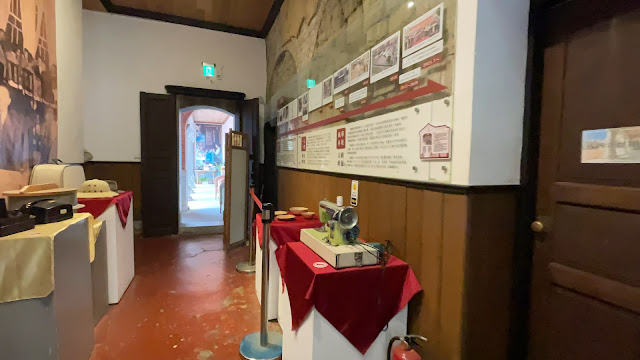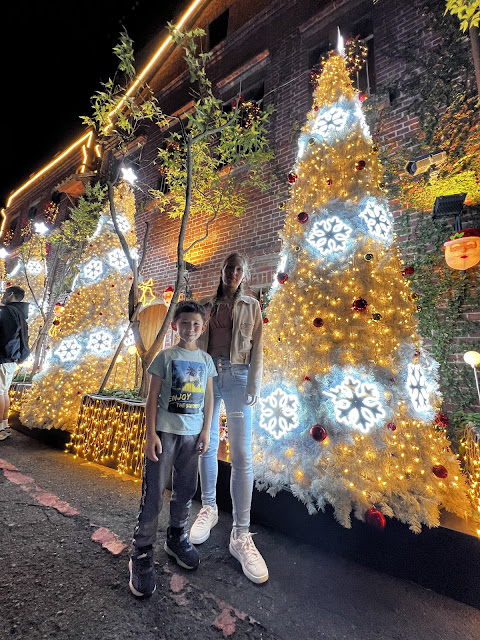Travel Date: 2024/11/23
This time, we visited Taichung, starting our day by looking for food. Just near the place where we parked, we found a ramen shop with a friendly Labrador inside. The food tasted great too!
The first place we visited was Yide Mansion, which combines Western and traditional elements. Next, we stopped by the Japanese dormitory area from the former Taichung Prison. Nowadays, it’s a comic museum, and it was filled with stalls featuring various comics.
After that, we went to see the Taichung City Hall and Prefectural Hall, which are located on opposite sides of the road. Unfortunately, the Prefectural Hall is currently under renovation.
From there, we headed to the Sun Cake Museum, but unfortunately, it had closed just 10 minutes before we arrived. The place stays open until 5:30 PM, but the museum itself closes at 4 PM.
Since we were not far from the train station, we went to the Taroko Mall behind it. We had dinner there, and since it was already dark, we walked back to see the Christmas decorations.
Sadly, this year’s decorations were quite poor compared to last year. The train station had none at all, but the BBQ shop nearby was as great as ever.
At the end of the day, we also visited Mitsukoshi Mall and Top City, but their decorations weren’t as impressive as they used to be either.
After spending the whole day in Taichung, I felt a bit bored and unsure why we actually came here. It’s not my favorite city, and the cloudy weather didn’t help much either—especially since it was a beautiful blue sky before we arrived.
Yi-De Mansion (一德洋樓)
Nestled in the bustling Beitun District of Taichung City, Lin Mao-Yang's Former Residence (林懋陽故居0, also known as Yi-De Mansion (一德洋樓), offers a glimpse into Taiwan's rich architectural and cultural history. This historic site, a harmonious blend of traditional Chinese and Western influences, has been lovingly preserved to share its unique story with visitors.
Dating back to 1928, Lin Mao-Yang's former residence is a testament to the vision of its creator, Lin Mao-Yang, a prominent figure of the Shen'gang Lin family. Lin commissioned this estate after marrying into the wealthy Lai family of Beitun. The property reflects a blend of courtyard house and elegant Western-style building.
The Courtyard House was built between 1924 and 1928, this traditional three-section design exudes charm with its red brick and cement stone walls. The main hall stands elevated, symbolizing its central importance, while the side wings showcase meticulous stonewashed finishes.
The Western-Style Building was added in 1929, this Art Deco masterpiece was designed for Lin’s third wife. Its colorful stonewashed exterior, intricate decorative details, and imported Japanese glass windows make it an architectural gem. Inside, bamboo-patterned staircases and Western-style rooms reflect the fusion of Eastern tradition and Western modernity.
After World War II, the residence transitioned into a military dependents' village, Yi-De Village, housing officers and their families. During this period, the estate's lush surroundings became a vibrant community space. However, years of use and neglect took a toll on the property.
In 2007, the site was officially recognized as a Historic Building, marking the beginning of efforts to preserve and restore its grandeur.
Preservation work began in 2013. The restoration team painstakingly recreated original features, crafting over 1,000 handmade bricks and sourcing special stonewashed finishes to revive its historical charm.
In 2017, the residence reopened as a cultural and recreational space, hosting cafés, exhibitions, and events. Although early management challenges arose, the site has since been reimagined and reopened in 2022, offering visitors a vibrant hub of history and culture.
Taichung Prison Officer Quarters (臺中刑務所官舍群)
In the heart of Taichung's West District lies a fascinating piece of history— the Taichung Prison Officer Quarters. Built during the Japanese colonial period, this group of residences showcases the evolution of Taiwan’s judicial history and architectural heritage. From housing prison officers to becoming the preparatory office for the National Comic Museum, this historic site has seen remarkable transformations.
Constructed in 1903, the officer quarters were originally part of the Taichung Prison complex, built to house prison staff and their families. This area became a small community with unique living arrangements reflecting the structure of the judicial system during the Japanese era.
The site saw its peak development after 1924, when the Taichung Prison was renamed Taichung Correctional Facility (刑務所) to reflect a shift from punitive practices to rehabilitation and education. This transformation is emblematic of the evolving attitudes toward criminal justice during the early 20th century.
The officer quarters are a mix of styles and building materials that reflect the changing times:
Colonial-era Residences include traditional wooden structures, brick-and-wood hybrids, and reinforced brick constructions. The variety speaks to the different ranks of officers housed here, from senior officials to rank-and-file staff.
After World War II, additional duplexes and four-family homes were constructed, further expanding the community.
Together with the Taichung Prison Warden's Residence and Taichung Prison Bathhouse, this site paints a vivid picture of life for correctional officers during Taiwan's colonial and early post-war periods.
The Taichung Prison Officer Quarters have undergone meticulous preservation efforts, ensuring their historic integrity remains intact. After being designated as Historical Buildings in 2013, the Taichung City Government, with funding from the central government, allocated over NT$223 million for restoration.
The restored buildings now span 20,645 square meters, encompassing the officer quarters, preserved landscapes, and surrounding areas. These efforts ensure that this architectural treasure will continue to educate and inspire future generations.
In December 2022, the Ministry of Culture assumed management of the site, transforming it into the National Comic Museum Preparatory Office.
The space is now a hub for comic enthusiasts, offering exhibitions, workshops, and events celebrating the art of storytelling through comics.
The museum is open 10:00 AM–7:00 PM on weekdays and 10:00 AM–8:00 PM on weekends, closed on Tuesdays and open during public holidays.
Taichung Prefectural Hall (臺中州廳)
Located in the West District of Taichung City, Taichung Prefectural Hall is a remarkable piece of architecture steeped in history and cultural significance. Constructed during the Japanese colonial era, this iconic building not only witnessed the evolution of modern governance in Taiwan but also continues to attract history enthusiasts and tourists alike.
The construction of Taichung Prefectural Hall began in 1912 and the first phase was completed in 1913. Over time, it underwent four expansions, reaching its current scale in 1934. Designed by Japanese architect Matsunosuke Moriyama, the building initially served as the Taichung Prefectural Government, administering Taichung City, Changhua County, and Nantou County.
As one of the "permanent administrative buildings" of the era, Taichung Prefectural Hall was built alongside its "sister buildings," the Taipei Prefectural Hall (now the Control Yuan) and the Tainan Prefectural Hall (now the National Research Center for Cultural Assets). It represents the architectural advancements of the time and highlights the transition to reinforced brick construction, marking a milestone in Taiwan’s modern architectural history.
The building is designed in the French Mansard style, reflecting a blend of European classical aesthetics and functional architecture:
The central tower stands out with Doric columns at the entrance and Ionic columns on the second-floor balcony, creating a layered visual effect.
The distinctive Mansard roof adds to its grandeur and symmetry.
The main entrance is positioned at a prominent street corner, emphasizing its importance in the cityscape and aligning with the planning principles of administrative buildings during the Japanese colonial period.
During the Japanese colonial period, Taichung Prefectural Hall served as a vital administrative hub. After World War II, it continued to house local government offices until Taichung City Hall was relocated. Today, the building is designated as a municipal historic site and serves cultural and educational purposes, preserving its legacy as a symbol of Taiwan's modern history.
The structure remains well-preserved, retaining most of its original features, making it a valuable case study for understanding Taiwan’s architectural evolution.
Guided Tours are available every Sunday (morning and afternoon sessions). Each session accommodates up to 30 participants. Reservations for tours open on the 1st of every month at 10 AM for the following month.
Taichung City Hall (臺中市役所)
Taichung City Hall is a stunning historical and cultural landmark. Built during the Japanese colonial era in 1911, this architectural gem seamlessly blends Western classical style with local heritage. Today, it serves as an artistic and cultural hub, offering visitors a unique blend of history, art, and gastronomy.
Originally constructed as the Public Irrigation Association Office and later used as an administrative office during the Japanese colonial period, Taichung City Hall is a shining example of Tatsuno-style red-and-white brick architecture. Notably, it was the first building in Taichung to use reinforced concrete, reflecting the era’s architectural advancements.
The building is modeled in Baroque style, featuring tall Ionic columns frame the main entrance, with intricate detailing such as medallions and keystones. The classical wooden dome, adorned with eight tiger windows, is a rare structural feat for its time and a striking feature of the building. The construction combines brick, wood, reinforced concrete, and steel, showcasing cutting-edge techniques of the early 20th century.
Designated a historical building in 2002, Taichung City Hall underwent careful restoration and reopened in 2016, preserving its architectural and historical essence.
Christmas
We have also visited a few shopping malls, but there were not many decorations in Taichung yet.
%202%20(1).jpg)









































0 komentarze:
Post a Comment